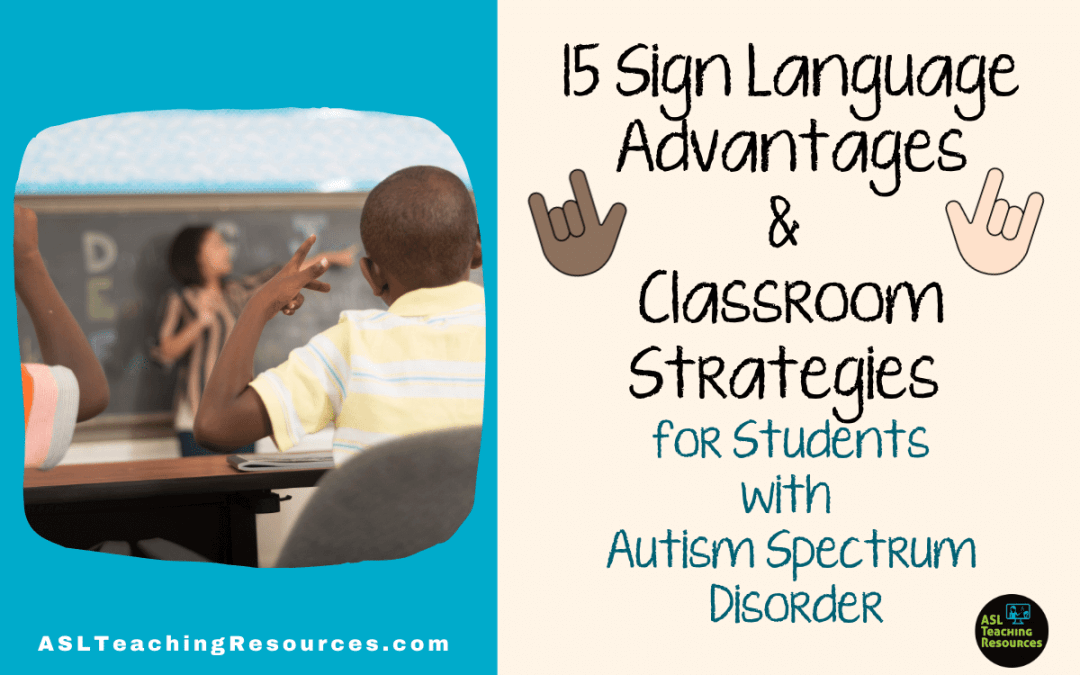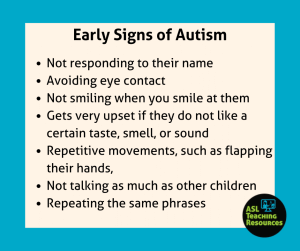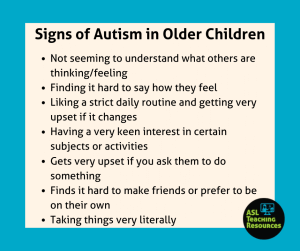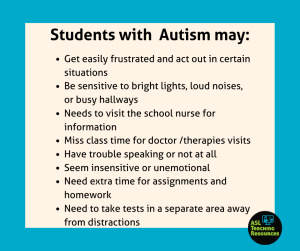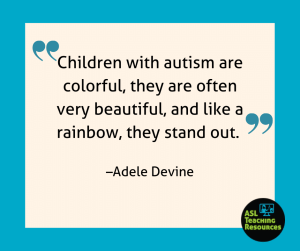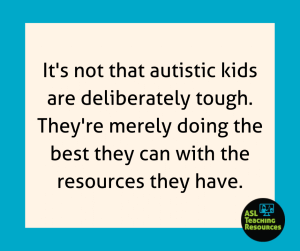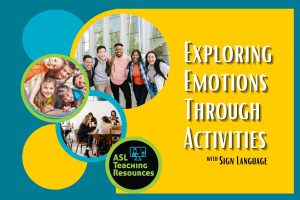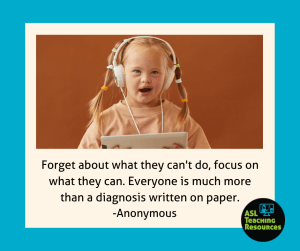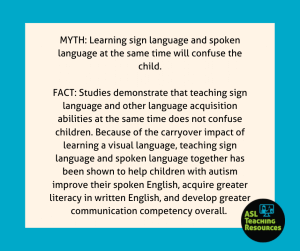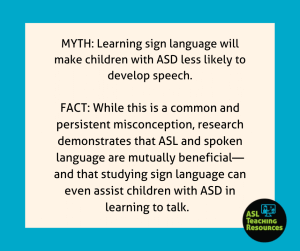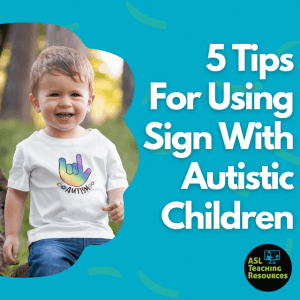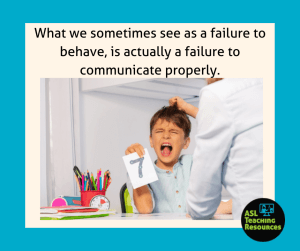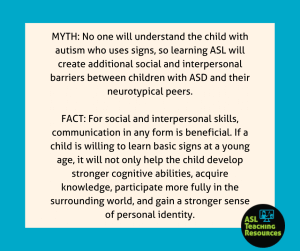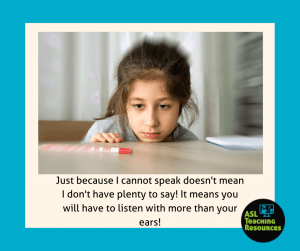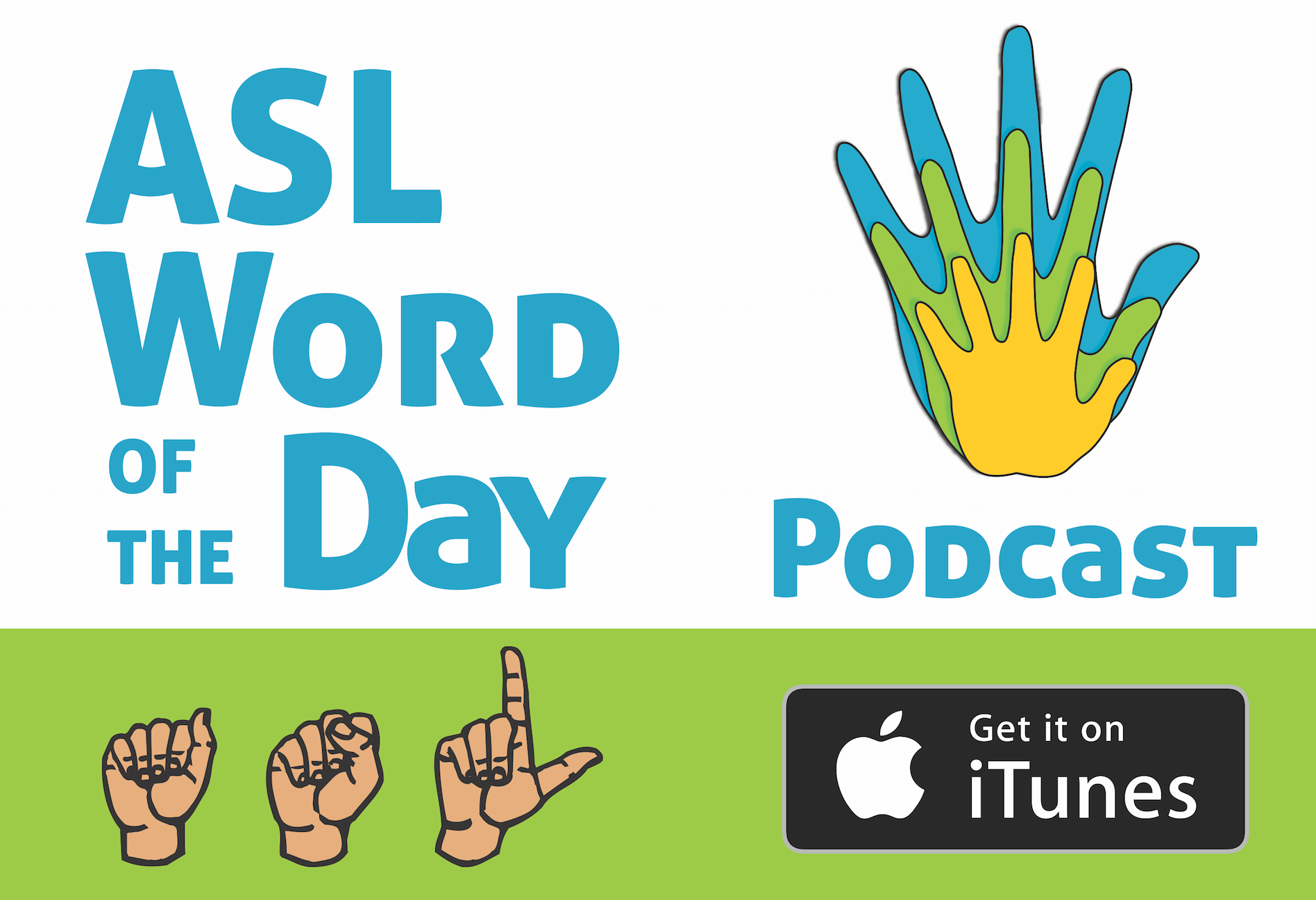Many individuals with autism spectrum disorders (ASD) attend regular classes. A general education teacher may feel comfortable having a student with ASD in his or her class in some cases. Some general education teachers, on the other hand, may feel uneasy, fearful, overwhelmed, or hesitant. All of these are legitimate feelings. Sign Language Advantages & Classroom Strategies for Students with Autism Spectrum Disorder contains all of the information you need to begin assisting your autistic students!
Teachers have long felt unprepared to teach students with autism spectrum disorders. There are reasons for their apprehension, as well as solutions to help them feel more engaged and capable. Those of us who have experience working with autistic individuals and feel confident in our abilities can support our colleagues in the classroom and discuss the benefits of using sign language
Rather than viewing a child with autism as a source of ineptness, see it as an opportunity to learn new approaches to old problems: a chance to rediscover the challenges and rewards that education can provide. Take the time to get to know each of your students, and be a teacher who recognizes that learning has ups and downs. These stumbling blocks could be viewed as opportunities for growth rather than a barrier to achieving your goals.
Communication is an essential component of both teaching and learning. ASL Teaching Resources created the Sign Club for Children just for you! Assisting you in incorporating Sign Language into your classroom or outside. Prepare to feel less stressed, overwhelmed, and in control of your time, allowing you to relax knowing you have the tools you need to educate your students better than ever! This Club will improve learning by utilizing visual, auditory, and kinesthetic methods to reach all students. Concepts can be used with a wide range of preschool and elementary children, including those who are autistic, deaf, hard of hearing, hearing, or ESL. The club’s goal is to raise awareness of the language through fun and engaging activities over its 26-week curriculum. See a sneak peek here.
This Sign Language Advantages & Classroom Strategies for Autism blog was developed for educators, but it might also be useful for others. Please share this information with your pupils’ caregivers/parents.
What Every Teacher Should Know About Autism
Autism Spectrum Disorder (ASD) is one of the most rapidly growing developmental disorders in the United States. ASD is more common in children than cancer, diabetes, and AIDS combined. Autism affects one out of every 44 children in the United States. Autism affects deaf people more than hearing people.
Boys are diagnosed with ASD approximately five times more frequently than girls. Because autistic behavior in girls frequently differs from the norm, some clinicians frequently overlook it.
What is Autism Spectrum Disorder?
Autism is a developmental disorder characterized by substantial social, communicative, and behavioral difficulties. Because autism is a spectrum condition, the combination of symptoms and severity varies from one person to the next.
A diagnosis of ASD (Autism Spectrum Disorder) now encompasses several conditions that were formerly diagnosed separately:
- Autism
- Pervasive developmental disorder not otherwise specified (PDD-NOS)
- Asperger syndrome
What Do Autistic Students Need from Teachers?
No Labeling
You’ll probably encounter a lot of detailed and scientific evidence about your student’s autism diagnosis as a teacher. But keep in mind that a child’s spot on the spectrum should not be used to label them. Keep reminding yourself that children can move in any direction along this spectrum.
Respect Our Uniqueness
Teachers must realize that every child on the autism spectrum is different, and what identifies one may not apply to another. While some autistic children are nonverbal, others have incredible musical and artistic abilities. Autistic individuals have their unique set of skills and limitations. Some people thrive with memory, but struggle with reading and phonetically sounding out words. Teachers should expect their students to struggle with various subjects to differing degrees (or not at all).
Show Interest in My Special Interests
Autism Spectrum Disorder (ASD) students frequently have a variety of interests (read: obsessions). While teachers do not have to cater to these interests all the time, they can be used as a learning motivator. If a child is very interested in computers, for example, utilizing computer time as a break can be beneficial. Teachers may find it useful to tie the content being studied to the child’s interests when appropriate.
Schedules and Routines Please
Teachers can aid in making a student’s educational life as stress-free as feasible by learning the child’s schedule and adhering to it as closely as possible. It’s possible that doing so will avert a meltdown or undue tension. Consider organizing each school day, in the same way, to establish your classroom routine, since studies have shown that a consistent schedule benefits all children, not just those with autism.
Routine is essential for children with autism. A simple alteration in that routine, even if it appears to other youngsters to be a delightful surprise, could be disastrous. Simply notify the autistic student when a change in routine is scheduled or likely to occur so that they can begin to prepare themselves. Children will be able to express themselves and communicate their wants and needs as a result of daily routines, which will help them communicate effectively and build their confidence.
Use these Communication Visual Schedule Cards to help nonverbal children improve their communication skills! Create a structured environment in which they can feel in control!
Get your DailyRoutines in ASL here!
Choices, Choices, & More Choices
Clear choices benefit all children, especially those on the autism spectrum. Avoid asking open-ended questions like, “What recess activity would you like to do today?” “Would you rather play Sharks and Minnows or Capture the Flag?” instead say “Play Sharks and Minnows?” or “Let’s play Capture the Flag?” Such clear choices result in less processing time, fewer disputes, and a stronger sense of community in the classroom.
Sensory Awareness Is Everyday
When you have sensory impairments, you generally aren’t aware of them. You turn down the music if it’s too loud, and you take off your sweatshirt if it’s too hot. Children on the autism spectrum, on the other hand, are unable to cope with sensory challenges in the same way that neurotypical children can because their senses tend to give them inaccurate information. Before welcoming an autistic child into the classroom, teachers should learn what sensory issues they have and what kinds of sensory issues they are likely to encounter.
Stimming and Self-Regulation are Good
Stimming is a common activity among children on the autistic spectrum. Flapping their hands, rocking back and forth, twirling, or pacing are examples of these activities. While such stimming actions can be disturbing to both the instructor and other students, teachers need to understand that this type of conduct is not intended to be annoying. Rather, it’s a comforting rhythm that the child recognizes.
On the autism spectrum, a child’s senses work overtime, providing him with unreliable information. As you may imagine, this is taxing. Allow an autistic child to get a bonus of downtime if she has met the needs set for her. This might be as simple as sitting in the corner for 10 minutes with a book and headphones. Allow the kid to unwind. That time in the corner with a book and headphones doesn’t have to be a treat all the time. A teacher may discover that enabling a child to decompress frequently improves the overall experience for everyone.
Living with autism means having a sensory system that continually bombards you with information that may or may not be correct. If you see an abrupt change in your autistic student’s behavior, realize that it is unlikely that the student is acting rudely for attention or entertainment. Rather, he or she could be anxious because of the environment.
Keep in mind that autistic youngsters do not melt down to generate a commotion. Rather, they break down because their senses are all jumbled up and it’s the only thing, they can think of to do. The finest thing you can do as a teacher is to have a calm and encouraging demeanor.
Assist With My Social Skills & Rules of Engagement
During free periods like lunch and recess, students on the autism spectrum, like any other child, require socializing. The child, and very definitely their parents, would enjoy an extra set of eyes on them to ensure that these social occasions are helpful to both the student and his or her peers. Children on the autism spectrum have difficulty understanding social cues, which can lead to confusion and embarrassment among peers and the child. Teachers can aid by paying close attention to their students’ social situations and, where necessary, modeling appropriate behavior.
Spend time teaching an autistic student very specific social rules and abilities. Just a few examples include how to wait for the slide, how to ask a neighbor for a pencil, and how to congratulate the winning team after a game of dodgeball.
Social-emotional awareness is critical in the life of an autistic child. Emotions ASL in the Classroom, for example, can help teachers answer questions like, “How do I approach teacher-child interactions that will have a direct impact on your student’s social and emotional needs?”
Because autistic children frequently lack social skills, they may make hurtful or inappropriate comments. Teachers should expect direct and literal responses. Rather than taking criticism personally, teachers should find the courage to lead by example with words of praise and positivity.
Students’ knowledge of identifying and understanding emotions can improve by exploring emotions through activities. Students feelings are important because they influence how they learn and thrive in school and later in life. Students who are happy are more likely to stay on task, focus, and welcome new learning experiences. While anxious or scared students will shut down or withdraw, avoiding new learning experiences. Emotions are powerful, and their impact on learning is undeniable. Support your students by incorporating SEL activities into your daily routine, and explore emotions through activities.
Limited Motor Skills, But Not Limited in What I Can Do
Motor skills may be a problem for autistic students. For those autistic students in the classroom, it may be good for teachers to examine alternatives to writing by hand, such as an iPad or laptop. One of the most effective ways to strengthen a child’s fine motor abilities is to have them hold and use writing implements. Coloring and drawing provide rapid visual feedback that varies depending on the tool and how it is used by your child.
Give Me Extra Time to Process Language
Children on the autistic spectrum frequently struggle to comprehend verbal instructions. Use as few words as possible when delivering guidance so that the autistic child has less to process. Separately deliver directions to the autistic youngster if necessary. Teachers may need to devise a variety of methods for giving directions. For an autistic youngster who has difficulty comprehending verbal directions, providing visual aids and/or writing instructions in a few easy-to-follow steps could be quite beneficial.
Autistic children require extra time to process language. After delivering spoken directions, if you get a blank gaze, know that the child is probably still digesting. Repeat the directions in the same language to assist them. Changing the terms will simply need them to restart their process. The advantage of using sign language to communicate is that signing is visual communication, and most autistic children can process the visual command faster than a verbal one.
Speak Literally
While you might use sarcasm, idioms, or a raised voice to communicate with other children, keep in mind that autistic students will not respond in the same way. If you compare an autistic child to a sibling or another student, or if you bring up unrelated or old incidents, he or she will not understand. In the best-case situation, this form of communication is perplexing. Worst case scenario, they’re terrifying. Common phrases like “go on a wild goose chase,” “give someone the cold shoulder,” and “get a taste of your own medicine” are difficult for children on the autistic spectrum to comprehend. If educators avoided them, they would produce less confusion.
15 Reasons Why Autistic Children Should Learn Sign Language
It is estimated that 40% of children diagnosed with autism spectrum disorder are non-verbal. Although some autistic children are nonverbal, this does not rule out the possibility that they have something to communicate. Expect your autistic kids to have as many ideas and opinions as any other student, however, you may need to encourage them to share them uniquely.
Is there sign language for autism? Perhaps you’ve heard of baby sign language or sign language for the deaf, but did you know that sign language can be a valuable communication tool for people on the autism spectrum? What are the advantages of learning sign language?
Why Sign Language for Autism?
The visual feature of sign language makes it much more accessible to the autistic brain than verbal communication, which can be exceedingly difficult for autistic youngsters to understand and use.
1. SIGN LANGUAGE IS A VISUAL LANGUAGE.
ASL is a visual language as a whole. Teaching children ASL can help them gain comprehension because the information is expressed through a combination of handshapes, palm orientations, hand movements, and facial expressions. Visual information is easier for autistic children to absorb than spoken information. Temple Grandin, a well-known autistic adult, describes this visual predisposition as “thinking in pictures.“
2. SIGN LANGUAGE IMPROVES COMMUNICATION SKILLS BY PROVIDING A CLEAR, VISUAL WAY OF COMMUNICATION TO THE LEARNER.
When sign language is combined with speech, it improves children’s comprehension. A combination of sign language and ongoing speech therapy (dubbed “simultaneous communication”) can help children with autism develop language skills. It promotes early language development, brain growth, and motor skill development. It also incorporates the natural tendency to gesture and gives gesturing a purpose, making it an effective mode of communication.
3. WHEN SIGN LANGUAGE IS USED, DIFFICULT BEHAVIORS WILL DECREASE.
Many of the challenging behaviors seen in autistic children, such as yelling, punching, biting, and so on, can be traced back to a lack of communication abilities. Consider how aggravating it would be to be unable to articulate a want or requirement. Those challenging behaviors will lessen as soon as you provide your child with a clear and functional means of communication.
4. IMITATION SKILLS CAN BE BUILT BY USING SIGN LANGUAGE.
During the teaching process, your child or students will learn imitation skills as well as sign language. While imitation and communication may appear to be unrelated, there is a strong link between them. The ability to imitate has been linked to the development of language and play skills in children with ASD. Recently, it has been recognized that there is a link between the ability to mimic other people’s actions and an important skill required for meaningful communication, known as “intentional communication.” ASL helps children remember words because it involves muscle memory and the more senses involved in learning, the better the child’s memory retention.
5. RESEARCH SHOWS THAT USING SIGN LANGUAGE AIDS IN VERBAL LANGUAGE DEVELOPMENT.
Sign language and other alternative communication methods do not prevent children with speech delays from speaking. On the basis of evidence, it may improve their communication skills. Due to very complex challenges in the visual, auditory, spatial, and tactile sensory systems, children with relating and communicative disorders frequently struggle to comprehend a wide range of meanings for concepts and relations expressed through words. Signs provide a visual cue to language for those who need extra help. ASL helps children understand and comprehend language by providing them with additional information about the meanings of words, events, concepts, and relationships.
6. SIGN LANGUAGE PROVIDES A WAY TO COMMUNICATE WITH THE 25% OF AUTISTIC INDIVIDUALS WHO MAY NEVER USE WRITTEN LANGUAGE.
It is estimated that approximately 25% of autistic people will never acquire any sort of spoken communication. For those youngsters who are unable to learn spoken language, sign language will be a vital asset that will allow them to communicate and express themselves while also connecting them to a larger network of people who communicate through sign language.
7. SIGN LANGUAGE INCREASES INTERACTION AND PLAY OPPORTUNITIES.
Sign language instruction is just one of several effective strategies for encouraging active, hands-on learning and development in your curriculum. Students’ growth and development can benefit from early exposure to sign language in a variety of ways. Sign language is a fun and playful way for preschoolers to learn and remember ABCs, Numbers, Colors, Rhymes, and more. ASL for elementary-aged children learning in core concepts, a large vocabulary, and phonemic lessons. They become acquainted with the United States’ fourth most common language.
8. SIGN LANGUAGE ASSISTS IN THE DEVELOPMENT OF SOCIAL SKILLS.
Another sign language advantage is that Autistic children will be able to communicate with other children and learn new social skills if they have a robust communication system in place. Many times, fellow students will want to learn sign language to be able to communicate with their friends. This is another advantage of sign language!
9. SIGN LANGUAGE FORMS A CLOSER BOND BETWEEN THE CHILD AND HIS OR HER PARENT OR TEACHER.
Teachers and family are on the same team!
10. THE USE OF SIGN LANGUAGE ALLOWS SIBLINGS TO COMMUNICATE WITH EACH OTHER.
Sign language offers advantages for the whole family to communicate.
11. MEALTIMES ARE EASIER WITH SIGN LANGUAGE.
Imagine another advantage of using sign language, what if your child could ask for what he or she wanted to eat instead of mealtimes being a time when meltdowns are nearly inevitable? With a sign for each meal and drink, your child will be able to ask for what he or she wants without having to resort to other behaviors.
12. DAILY ACTIVITIES WILL GO MORE SMOOTHLY IF SIGN LANGUAGE IS USED.
Sign language helps our autistic students. Everyone will be happier when genuine communication is possible. Giving your child a visual means of communicating with you will also make daily activities like going to the park and going to school, and following instructions much easier.
13. MORE LEARNING OPPORTUNITIES ARE PROVIDED BY THE USE OF SIGN LANGUAGE.
ASL ensures greater learning, interaction, and communication. Sign language can assist in reducing challenging behaviors caused by poor communication skills..
14. SIGN LANGUAGE IS AN ACTUAL LANGUAGE WITH A COMMUNITY AROUND IT.
If your child is unable to develop verbal language for any reason, knowing sign language will allow him or her to participate in an existing community because they share a similar mode of communication.
15. FINALLY, USING SIGN LANGUAGE AT HOME OR IN THE CLASSROOM WILL INCREASE HAPPINESS AND HARMONY.
At the end of the day, having a good sign language program in place will make your home or classroom a much happier environment, which is, after all, the purpose of anything you teach, right? Everyone will be happier once you’ve enhanced learning, interaction, communication, and fun while decreasing challenging behaviors caused by a lack of communication skills. These sign language advantages will have you asking, “why didn’t I start this earlier?”
Many children with autism have been able to learn and communicate successfully via sign language because it is visually based, unaided, and provides a mode of quick communication. A huge advantage of sign language is that it is something that can be easily learned and used anywhere, at any time.
The advantage of using sign language is that it provides a way for the child to communicate you can help reduce negative behaviors that arise from the child’s inability to communicate their immediate wants and needs. 5 Tips for Using Sign Language with Autistic Children can provide helpful tips from the teachers, parents, and deaf adults’ personal experiences, and the advantages of using sign language for communication with Autistic children.
One of the most challenging jobs in the world is that of a teacher. That’s why ASL Teaching Resources designed the Teacher Starter Kit specifically for you! Prepare to feel less stressed, less overwhelmed, and more in control of your time so you can relax knowing you have the tools you need to educate your students better than ever! Watch this 1-minute video that explains how we can help you lighten your load.
Get a free teacher starter kit here!
Tips For Creating an Inclusive Classroom
From the Learner, Learn About the Learner.
Fascinations should be taught. Educators should employ interests, strengths, abilities, areas of expertise, and gifts as teaching tools wherever possible.
Start A Conversation.
While it is critical for those outgoing and verbal students to have a voice in the classroom, it is also critical for other students, including shy and quiet students, students learning English as a second language, and students with disabilities, to have opportunities to share and challenge ideas, ask and answer questions, and exchange thoughts. Sign Language offers many advantages for open communication. Teachers must provide structures and activities that allow all pupils to interact to ensure that they have opportunities to communicate.
Maintain Your Daily Schedule
When it comes to autism, structure or regularity is the name of the game. Using Communication Visual Schedules will enhance communication skills for nonverbal children. Visual/Picture schedules will create a structured environment that they can feel in control of! A must-have for teachers and parents.
In the Classrooms
Create a teaching environment that is free of distracting stimuli. Bright lighting and overly decorated classrooms are just a few thoughts to consider.
Short & Simple
Because an autistic learner may struggle to retain the full procedure, keep vocal instructions short and to the point.
For Visual Learners
Use signs, drawings, and demonstrations. The advantages of using sign language are undeniable for visual learners.
Give Options
The fewer options, the easier it is for an autistic child to make decisions.
Check-In
To improve kids’ social skills, have a few structured one-on-one conversations with them. Because autistic children can’t read body language or feel a touch like you do, it’s advisable to avoid making physical contact with them without their permission.
Repetition Matters
When working on projects, aim for repeating actions. Workbox duties, such as putting away erasers and pencils, are common in autism classrooms. This level of regularity aids autistic children in maintaining their organizational skills.
Collaboration is Key
The actual experts for autistic children are their parents and caregivers. As a result, to effectively help the child both in and out of school, teachers should collaborate and share information. You can, for example, share notes on treatments that have worked at home and school and then integrate them as needed. Share the advantages of Sign Language for their Autistic child.
Finally, we must remember you, dear teacher. Teaching students with autism can be difficult even when you’re doing everything properly, so creating resilience is essential.
The final Sign Language advantage – learning ASL can be Fun!
Sign Language Blogs & Resources
How to Learn ASL Fast and Easy
10 Courses to Step Up – Your ASL Game
Autism Resources

